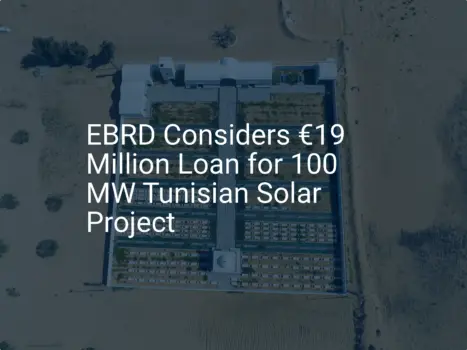The Strategic Blueprint: 3 Reasons a DESERT+ Solar Factory in Tunisia is a Winning Investment
It’s a common assumption that more sun automatically means more solar power. Yet for standard photovoltaic (PV) modules, the extreme heat and intense UV radiation of desert environments can significantly reduce performance and accelerate degradation. This reality reveals a critical market gap: a demand for specialized modules engineered to thrive in the very conditions that cause others to falter.
For the discerning investor, this challenge presents a unique opportunity. Establishing a manufacturing facility in a strategic location like Tunisia, dedicated to producing high-performance modules for arid climates, can create a powerful competitive advantage. This article makes the business case for such an enterprise, focusing on the technical foundation, investment requirements, and market strategy for a factory specializing in DESERT+ technology.
The High-Irradiance Challenge: Why Standard Modules Underperform in Hot Climates
Most standard solar modules are tested and rated at Standard Test Conditions (STC), which include a cell temperature of 25°C. In real-world applications across North Africa and the Middle East, however, module temperatures can easily exceed 60-70°C. This discrepancy lies at the root of a significant performance issue.
Every solar module has a ‘temperature coefficient of power,’ a metric defining how much its output drops for every degree Celsius above 25°C. For conventional modules, this figure is often around -0.35% to -0.45% per °C. In a 65°C operating environment, that translates to a power loss of 14% to 18%—a substantial reduction in both energy yield and revenue.

Furthermore, extreme conditions accelerate common degradation mechanisms:
-
Light-Induced Degradation (LID): A loss of performance that occurs within the first few hours of sunlight exposure.
-
Potential-Induced Degradation (PID): A performance loss caused by voltage differences, which is exacerbated by high temperatures and humidity.
-
Material Degradation: The encapsulants and backsheets that protect the solar cells can yellow and crack under intense UV radiation and thermal stress, compromising the module’s lifespan.
Together, these factors mean that deploying standard modules in desert regions often leads to a lower-than-expected return on investment.
Ready to make big Profits?
The solar Industry is Booming
WE HELP NEWCOMERS to the solar industry start their own solar module production line. Customers can make BIG PROFITS by selling modules and finding investors, without wasting money and time on things they don't need!
A Specialized Solution: The Engineering Behind DESERT+ Technology
To address these challenges, specialized modules have been developed, such as J.v.G. Technology’s DESERT+ concept. This purpose-built solution is engineered for optimal performance and longevity in hot, arid climates; it’s not a single component but a complete system of carefully selected materials and design principles.
Key Components of DESERT+ Modules:
-
Low Temperature Coefficient Cells: At the module’s foundation are high-efficiency solar cells specifically manufactured to have a superior temperature coefficient (e.g., -0.29% per °C), minimizing power loss in high heat.
-
Advanced Encapsulation Materials: Instead of standard EVA (ethylene vinyl acetate), these modules utilize materials like POE (polyolefin elastomer), which offers superior resistance to UV degradation, moisture ingress, and PID.
-
Highly Stable Backsheets: The backsheet is the module’s primary defense against the elements. DESERT+ modules use multi-layered, UV-resistant backsheets that prevent cracking and delamination over a 30+ year lifespan.
-
Anti-Reflective Coated Glass: The front glass is treated with a special coating that reduces reflection and maximizes light absorption, especially during the early morning and late afternoon when the sun is at a low angle.
-
1500 V System Design: These modules are often designed for a 1500-volt system architecture. This design allows for longer strings of modules, reducing the amount of cabling, combiner boxes, and labor required, which in turn lowers the overall Balance of System (BOS) costs for large-scale solar farms.
The final module not only produces more energy (higher kWh/kWp) but also maintains its performance for longer, ensuring a more reliable and profitable long-term investment for the end-user.
The Tunisian Advantage: A Strategic Hub for Manufacturing
Locating a specialized module factory in Tunisia offers a compelling mix of logistical, economic, and political advantages. The country is well-positioned to serve as a manufacturing and export hub for key growth markets.
Strategic Location
Tunisia’s proximity to Europe, the Middle East, and the rest of Africa offers significant logistical benefits. It has direct shipping routes to major markets in Southern Europe (Italy, Spain, France) and across North Africa and the Middle East, reducing transportation costs and delivery times compared to manufacturers in Asia.
Favorable Investment Climate
The Tunisian government actively encourages investment in renewable energy through its ‘Tunisian Solar Plan 2030,’ which aims to increase the share of renewables in its electricity mix. This commitment fosters a stable policy environment and provides access to various investment incentives for companies establishing local manufacturing operations.
Market Access and Growing Demand
Demand for high-performance solar solutions is growing rapidly in the MENA region. Large-scale solar projects in countries like Saudi Arabia, the UAE, and Egypt require modules that can withstand local environmental conditions. A Tunisian factory can supply these projects with a regionally manufactured, technologically superior product, often benefiting from preferential trade agreements.

Establishing a Specialized Factory: Key Investment Considerations
Building a factory for DESERT+ modules requires a deliberate approach focused on specialized equipment and quality control. A typical starter facility with an annual capacity of 50-100 MW serves as a practical model.
Initial Investment and Infrastructure
The Initial Investment for a 50 MW turnkey production line typically ranges from €5 million to €8 million. This includes:
-
Machinery: Specialized stringers, laminators, and testers calibrated for the specific materials used in DESERT+ modules.
-
Building & Facilities: A factory floor of approximately 2,500 to 4,000 square meters is required for production, warehousing, and office space.
-
Working Capital: Funds for procuring the initial inventory of raw materials like solar cells, glass, and POE encapsulant.
Labor and Operations
A 50 MW factory operating on a two-shift basis would typically employ around 40 to 60 individuals, including production line operators, quality control technicians, maintenance staff, and administrative personnel. Tunisia’s well-educated workforce offers a strong talent pool for these roles. Experience from past J.v.G. turnkey projects underscores the importance of a comprehensive training program to ensure high production standards from day one.

Market Strategy and Financial Projections
A factory producing specialized DESERT+ modules should not compete on price with mass-produced standard modules. The market strategy must focus on value, performance, and long-term reliability.
Target Customer Segments
-
Utility-Scale Solar Farms: Large project developers in the MENA region who prioritize long-term energy yield and a lower Levelized Cost of Energy (LCOE).
-
Commercial & Industrial (C&I) Installations: Businesses in hot climates looking for rooftop solar solutions that offer maximum energy production and a faster return on investment.
-
Specialized Projects: Installations for agricultural, oil and gas, or desalination facilities in remote desert locations where reliability is paramount.
Financial Viability
With an annual production of 50 MW, a specialized module factory can achieve strong financial performance. While raw material costs may be slightly higher than for standard modules, the premium selling price supports healthier profit margins, often in the range of 12% to 18%. With a disciplined operational plan, investors can typically expect a project payback period of three to five years.
Regulatory Compliance and Certification
To gain market access and build customer trust, modules must be certified to international standards. This includes the baseline certifications IEC 61215 (performance) and IEC 61730 (safety).
For a premium desert module, however, securing additional certifications that validate performance in harsh conditions is a key differentiator. These may include tests for:
-
Sand and Dust Resistance: Simulating the abrasive effects of sandstorms.
-
Ammonia and Salt Mist Corrosion: Essential for coastal desert locations.
-
Extended Thermal Cycling: Testing the module’s durability under extreme temperature swings.
Partnering with an experienced technical consultant like J.v.G. Technology can streamline this complex certification process, ensuring the final product is recognized globally for its quality and reliability.
Frequently Asked Questions (FAQ)
Why not just import standard, lower-cost modules for projects in Tunisia?
While the initial purchase price of standard modules may be lower, their reduced energy output and faster degradation rate in high-temperature environments lead to a lower lifetime return on investment. Specialized DESERT+ modules produce more energy and last longer, delivering a superior financial outcome for the project owner.
What is the typical timeline to set up a 50 MW solar module factory?
With a clear plan and an experienced turnkey partner, a solar module factory can be operational in approximately 9 to 12 months. This timeline includes factory planning, equipment manufacturing and shipping, installation, commissioning, and staff training.
Is a technical background in photovoltaics required to start this business?
No. Many successful solar manufacturing entrepreneurs come from other business sectors. The key to success is partnering with a technical consultant who provides a structured, guided process. Platforms like pvknowhow.com offer educational resources and expert support to bridge the knowledge gap for new entrants.
How does DESERT+ technology compare to bifacial technology?
The two technologies solve different problems and can be complementary. DESERT+ technology is focused on improving performance and durability in high-heat and high-UV conditions. Bifacial technology allows a module to capture sunlight from both its front and back sides. A premium module can incorporate both: using DESERT+ materials for durability and a bifacial cell design to maximize energy capture.
Conclusion: A Strategic Investment for a Growing Market
The global energy transition is creating highly specific regional demands. For investors with foresight, the opportunity lies not in competing with mass-market producers but in identifying and serving these specialized needs.
A solar module factory in Tunisia focused on DESERT+ technology is a strategic response to a clear and growing market gap. It leverages a superior technological solution, a favorable geographic location, and rising regional demand to create a defensible and profitable business model. For entrepreneurs ready to enter the solar manufacturing sector, this offers a clear pathway to establishing a leading position in one of the world’s most promising renewable energy markets.






